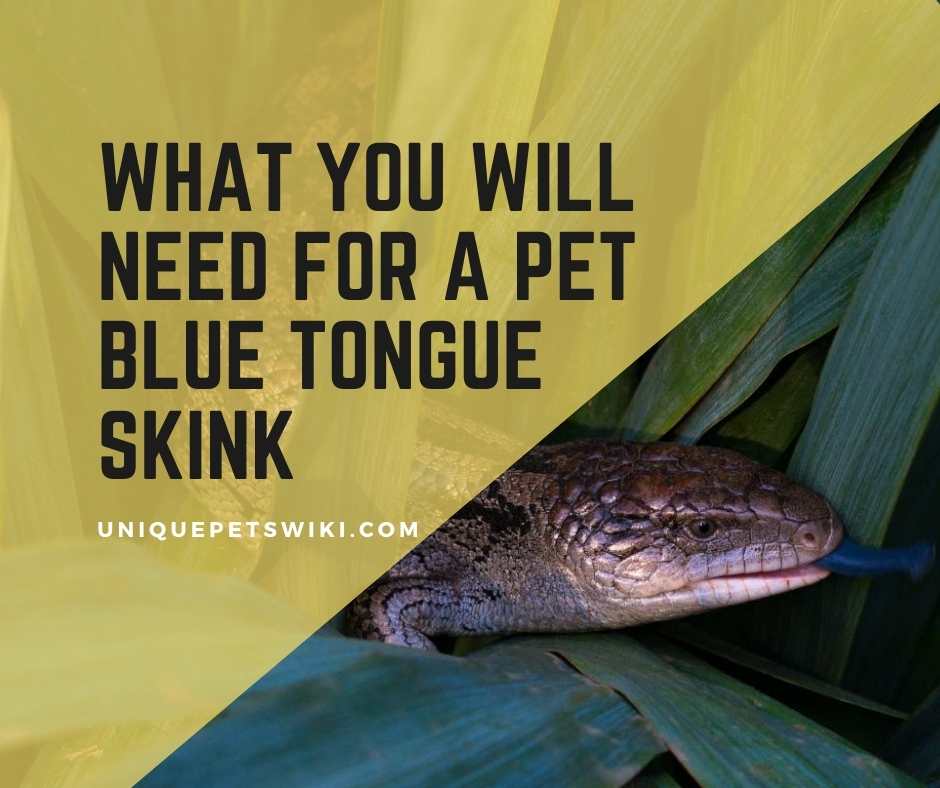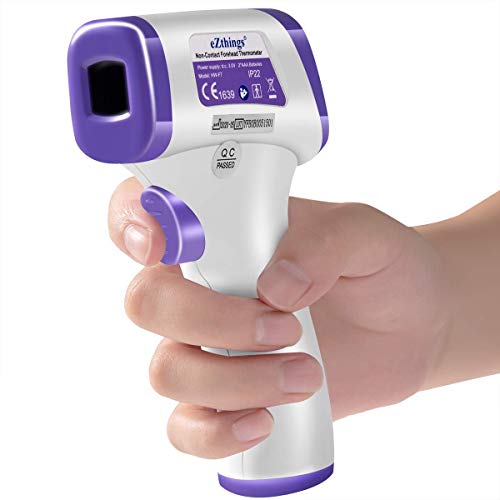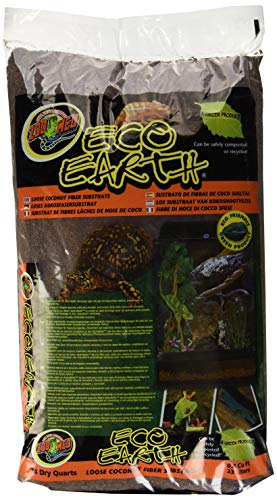Unlike a few decades back when information on blue tongue skinks were not readily available, making them your best reptile pets over other species of reptiles is now a fabulous choice.
You have tons of informative articles and websites like UniquePetsWiki dedicated to these beautiful docile creatures.
As a beginner, one of the challenges you will face is the headache of what exactly your new blue tongue skink pet would need and where to get the best products for your new pet.
Hang on, because you are in the right place. This article is a perfect shopping guide as far as what you will need for your blue tongue skinks is concerned.
In this article, we list all blue tongue skink supplies needed for keeping blue tongue skinks. Besides, you will also get recommendations on the best products, where to get them, and some professional tips for setting up and caring for your skink.
Contents
- Requirements For Setting Up Blue Tongue Skinks Habitat
- Reptile Enclosure – The TOP must Accessories
- Dome Heat Lamp With A Ceramic Socket – The Must Accessories
- Plug-in Lamp Dimmer x2 – The Must Accessories
- Bio Dude Digital Thermometer/Hygrometer – The Must Accessories
- Bio Dude Solar Grow 36″ Light Fixture – The Must Accessories
- Acardia Desert D3 + 12% UVB T5 Bulb – The Must Accessories
- T5 HO Fluorescent Light Fixture – The Must Accessories
- Basking Spot Lamp x2 – The Must Accessories
- Dual Dome Fixture – The Extra Accessories
- Basking Rock Or Stone – The Must Accessories
- Temperature Gun – The Extra Accessories
- Light Timer – The Extra Accessories
- Substrates – The Must Accessories
- Clean-Up Crew (CUC) – The Must Accessories
- Hides (cave) – The Must Accessories
- Decorations – The Extra Accessories
- Miner-All Outdoor Calcium Supplement And Exo Terra Reptile Multivitamin
- Food And Water Dishes
- Soft-Tipped Feeding Tweezers
- What Toys You Need For Blue Tongue Skinks
- Conclusion
Requirements For Setting Up Blue Tongue Skinks Habitat
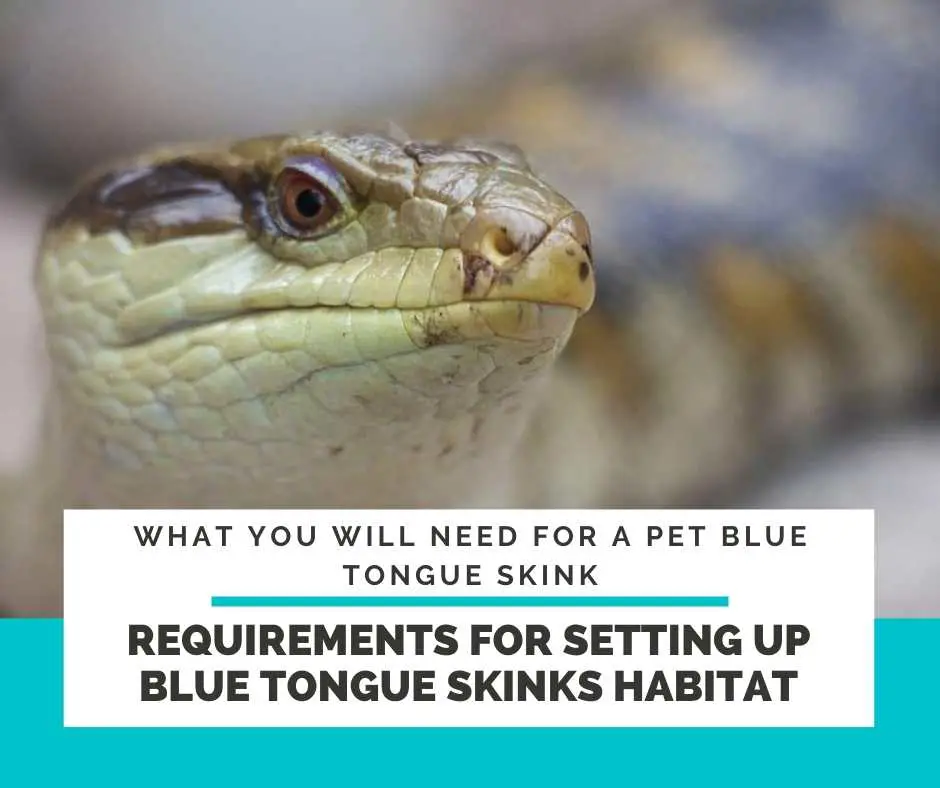
In this section, I will be taking you through all the fixtures you will need as a beginner to set up a home for your new blue tongue skink pet.
Each of these fixtures are prerequisites to setting up a new home for a blue tongue skink. Thus, none of the items in this list is less important or should be considered as not relevant for your new pet.
Reptile Enclosure – The TOP must Accessories
Last update on 2022-12-30 / Affiliate links / Images from Amazon Product Advertising API
The first thing you will need is an enclosure or terrarium or tank or vivarium or cage (all mean the house where your skink will live or be kept). Their enclosures are usually made of glass, wood, or plastic.
But before you set out to purchase an enclosure, you will have to understand that reptile enclosures come in different sizes, and the number of skinks you have or intend to get and their sizes will influence your choice of an enclosure.
Blue tongue skinks are naturally robust lizards. If cared for properly they can grow very large. So the minimum recommended size of an enclosure even for baby skinks is an enclosure with these dimensions: 36″L x 36″ W x 12″H.
The idea is since skinks are floor dwelling animals with short legs and cannot leap or climb very high, FLOOR SPACE becomes an important aspect of their enclosures over height.
Your skinks will be grateful to have an enclosure with enough ground space to encourage burrowing and hiding
Another crucial reason why floor space is best over excessively tall enclosures is that cages that are too high will create too much distance between the basking rock and the heat lamp. This will inevitably result in insufficient temperatures.
The size of your enclosure needs to be big enough. In fact, the more ground space it provides the better. For only one skink, the minimum floor area of 39 by 20 inches (100 by 50 cm) will be enough. But an area of 47 by 24 inches (120 by 60 cm) would be better.
The best material to consider for enclosures is PVC because of its waterproof and lightweight quality. Glasses and well-sealed wood also make good enclosures. Before purchasing, discuss your needs with your local pet supplier to know which type to pick within your budget.
As a matter of caution, do not house more than one blue tongue skinks in an enclosure. Keeping more than one skinks together will likely result in them fighting and getting themselves injured especially if they are male skinks.
On a final note, bear in mind that I’m not completely ruling out tall enclosures in any way. Big enclosures will work provided that you can consistently maintain the correct temperatures.
Dome Heat Lamp With A Ceramic Socket – The Must Accessories
Last update on 2023-01-02 / Affiliate links / Images from Amazon Product Advertising API
You’ll need a dome heat lamp with a ceramic socket for your overhead heat source to set up the basking area. This fixture will help to reflect the heat in the entire enclosure.
Plug-in Lamp Dimmer x2 – The Must Accessories
Last update on 2023-01-02 / Affiliate links / Images from Amazon Product Advertising API
This fixture is used to bring down the heat in your skinks’ enclosure should it get too hot.
Bio Dude Digital Thermometer/Hygrometer – The Must Accessories
Last update on 2023-01-02 / Affiliate links / Images from Amazon Product Advertising API
One crucial fact about blue tongue skinks is that they require specific temperature and humidity levels at different seasons within a particular sized enclosure. Thus, a good digital thermometer/hygrometer packed in one is required to help you regulate the temperatures.
We recommend this high-quality thermometer/hygrometer sensor on a single external probe from Bio Dude.
Bio Dude Solar Grow 36″ Light Fixture – The Must Accessories
You’ll need this UVB light fixture for your UVB bulb. The plants in your enclosure need it to thrive well and look fresh. Without the UVB bulb that supplies light as though in the natural habitat, the plants will wither away in a short time.
This fixture is great when used with Acardia Desert UVB Bulbs.
Acardia Desert D3 + 12% UVB T5 Bulb – The Must Accessories
We recommend this high-quality bulb from Acardia Desert for your enclosure. This bulb is built with quality to emit more visible light than the equivalent length D3 T8 lamp.
It is an essential fixture you must provide to aid the formation of vitamin D3 in your skinks, strengthen their immune systems, and stimulate the production of endorphins in male skinks.
T5 HO Fluorescent Light Fixture – The Must Accessories
Last update on 2023-01-02 / Affiliate links / Images from Amazon Product Advertising API
This fixture is needed to provide the right amount of UVB lighting for skinks. Blue tongue skinks are day-active reptiles so they need UVB lighting in their enclosures for their day to day activities and general wellness.
One other importance of this UVB lighting is that it helps prevent pathogens from thriving in the enclosure. Note that for optimal effectiveness, the bulb must be replaced every 6-months or at most once a year. To get the best results, use it with a reflective fixture.
While setting up the bulb, it’s best to set it up on the same side with the heat lamp half the full height of your enclosure because heat and UVB work together.
Basking Spot Lamp x2 – The Must Accessories
Blue tongue skinks rely greatly on their environments to regulate their body temperatures because they are endothermic. While setting up their basking spot, you’ll need a halogen flood bulb with a higher watts inside a dome heat lamp with a ceramic socket.
You’ll need two of these lamps to set up the basking area. One is to be used during the day and the other during the night when the temperature drops.
Dual Dome Fixture – The Extra Accessories
Last update on 2023-01-02 / Affiliate links / Images from Amazon Product Advertising API
This fixture will allow you to use two bulbs at the same time only that the specified bulb wattage shouldn’t be exceeded. While setting up the basking area, you can use it to fix your basking spot lamp to it.
Basking Rock Or Stone – The Must Accessories
You’ll need a large flat basking rock or stone to set up the basking area. To be placed directly under the basking spot lamp.
Temperature Gun – The Extra Accessories
Last update on 2023-01-06 / Affiliate links / Images from Amazon Product Advertising API
A temperature gun is essential to keep tabs on the temperature of the enclosure. An infrared temperature gun or digital probe thermometer gives more accurate and reliable results than a cheap gauge-type stick-on thermometer.
Light Timer – The Extra Accessories
Light timer is another must-have item to set up a skink’s enclosure. It is used to regulate day and night cycles for your skinks.
Substrates – The Must Accessories
Last update on 2022-12-29 / Affiliate links / Images from Amazon Product Advertising API
Another name for substrates are beddings or floor coverings. When choosing substrates for your blue tongue skinks, have in mind their burrowing nature to provide a substrate they can burrow in. You’ll need a 4-5 inches deep, soft, and loose substrate.
Another factor that’ll influence your choice of substrates is the species of skinks you have or intend to get. Blue tongue skinks are basically from two regions- the temperate region of which the Australian skinks belong to and the tropical region of which Indonesian skinks belong.
The temperate Australian blue tongue skinks require high or warm temperatures while the tropical Indonesian blue tongue skinks need mild or humid temperatures. So if your skink is from the Indonesian category, you’ll need a substrate that can retain their high humidity requirements.
We recommend using Reptichip, Lugarti Natural Reptile Bedding, or a semi-arid DIY mixture (this you can prepare it yourself by mixing 60% organic topsoil + 40% play sand) for Australian blue tongue skinks.
For Indonesian blue tongue skinks, ideal substrates include Reptichip, sugar cane mulch, sphagnum moss, and a moist DIY mixture. (To prepare this, mix 40 percent organic topsoil + 40 percent Zoo Med ReptiSoil + 20 percent play sand).
Beddings gotten from pine or fir or cedar wood products, Reptibark, Carefresh rodent bedding, and sand are not recommended because they are inadequate in terms of meeting blue tongue skinks’ humidity needs and can cause a significant health issue.
Some other common choices of beddings are Aspen shavings, carpet, carefresh, coconut fiber, and any other type of reptile substrate. I would recommend aspen shavings. It’s perfect for any species of skink.
Do not also use indigestible or non-natural substrates such as beech chips, crushed walnut shells, calci-sand, granules, or corn cob. These materials can be dangerous. They can block the digestive system (track) and cause impaction.
Clean-Up Crew (CUC) – The Must Accessories
Having a skink as a pet doesn’t mean your home should smell like a garbage truck. If you make cleaning the enclosure regularly a habit then you wouldn’t have issues with smells or parasites. However, to deal with the issue of cleaning, you’ll need a good clean up crew.
What is a clean-up crew? Clean up crew are small invertebrates used in keeping off pest algae, parasites, and detritus from reptile enclosures.
What the clean-up crew does is to simply recycle nutrients in the waste of your skinks and fertilize the soil beneath.
The aftermath results is that the plants in the enclosure will see nutrients to feed on and look fresh while the enclosure is kept clean. Best insects for the clean-up crew are Tropical grey woodlice, Springtails, White worms, and Bean weevils.
Hides (cave) – The Must Accessories
Last update on 2022-12-29 / Affiliate links / Images from Amazon Product Advertising API
Burrowing and hiding are an important aspect of blue tongue skinks’ nature. Take it away from them then they’re deprived of an essential ingredient for vitality.
For your new pet, you’ll need one warm humid and one cool dry hide. Large cork or logs make good hides, just place each on both the cool and warm side of the enclosure.
Decorations – The Extra Accessories
Last update on 2022-12-29 / Affiliate links / Images from Amazon Product Advertising API
The essence of decorating your skinks’ enclosures is to give them a natural or zoo-quality habitat. To make them feel as though in the wild. Without these items, your skinks will lack activities and what to feed their eyes while in their cage.
What you’ll need for decorating their enclosures include logs, climbing toys, plants, leaves, branches, etc. Hides and basking rock make up parts of decoration.
Depending on the type of substrate you are using, live plants make good decorations for your enclosure too. For beginners, pothos, wheatgrass, carrot tops, and asparagus fern are ideal for decoration.
Keep in mind that sinks are floor dwellers meaning they love to trample on plants so pick plants that can withstand trampling.
Your blue tongue skinks need climbing toys as part of their enclosure decorations too. Though they aren’t climbers or love to climb that much, medium-sized branches, cork bark, rocks and logs can be provided for this purpose to engage them in activities.
For more decoration ideas you can visit Petbackdrops. They offer a wide variety of lovely backgrounds to choose from for any kind of reptile enclosure.
Miner-All Outdoor Calcium Supplement And Exo Terra Reptile Multivitamin
Last update on 2023-01-02 / Affiliate links / Images from Amazon Product Advertising API
Blue tongue skinks are omnivorous meaning that they will get almost all the nutrients they need from their wide variety of diets. However, it’s not always so, especially for captive blue tongue skinks.
There are vitamins and minerals they require in higher quantities which their food cannot suffice. Because of that, there is always a need to supplement their diet to provide those vitamins.
The two basic nutrients usually supplemented are calcium and vitamin powders (vitamin D3 and vitamin A) which will be dusted or sprinkled on their diet.
If you consistently maintain the right UVB in your skinks’ enclosures you’ll not need a vitamin D3 supplement. But if you’re not sure of the UVB levels in their enclosures, it’s best to offer them vitamin D3 supplements.
Why they need vitamin D3 is to be able to absorb, store, and make use of calcium from their diet.
Calcium in turn will ensure strong bones and muscles and prevent any bone-related diseases like metabolic bone disease. For your blue tongue skinks, we recommend Miner-All Outdoor Calcium Supplement and Exo Terra Reptile Multivitamin.
Either of these brands has pure calcium supplement without vitamin D3 and calcium supplement fortified with vitamin D3. Take note that these two supplements should not be given too often because too much of it can be as dangerous as very little.
If you purchase a calcium supplement fortified with vitamin D3, you will not need a separate vitamin D3 supplement and vise versa.
Food And Water Dishes
Last update on 2022-12-29 / Affiliate links / Images from Amazon Product Advertising API
These are what you’ll use to serve your skinks food and water respectively. The food dish is to be removed once you notice that your skink is done eating to avoid bacteria from breeding or smelly enclosures.
As for the water dish, get a bowl that is large enough to soak your skinks as they may desire but shallow enough to prevent them from drowning. Make sure you refill the water dish with fresh water every day.
Soft-Tipped Feeding Tweezers
You’ll need this feeding aid especially for feeding hatchlings, picky eaters, or your adult skink who refuses to eat.
What Toys You Need For Blue Tongue Skinks
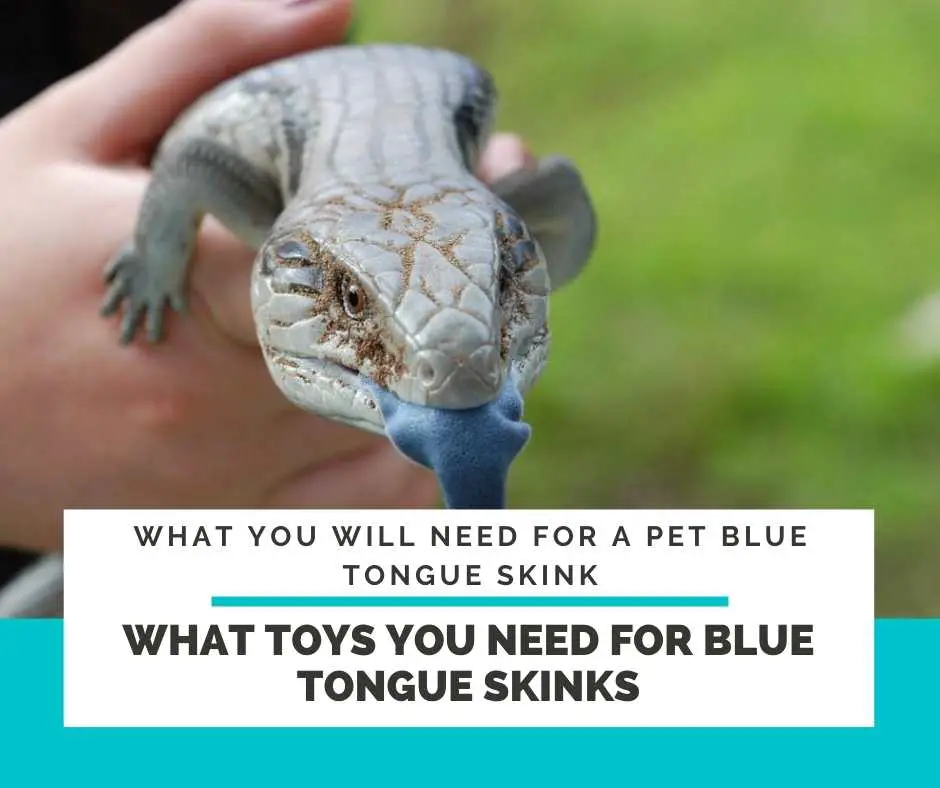
Getting toys for your skinks is as important as their enclosures and food. The toys will help enhance their health and general well-being.
Blue tongue skinks that lack toys for exercises and activities are often prone to some health issues like overweight and stress. Toys you would need for exercises and activities include:
- Foraging ball
- A Wiffle ball or volleyball
- A floatie
- A tunnel
- A hideout
- Bridge
- A cat wand
- A Lazer pointer
- Crinkled wrapping paper or cat toy.
Read more for information on how to use these toys to stimulate mental health and happiness in your skinks.
Conclusion
Make a mistake in setting up your new blue tongue skinks home and your lovely pet is going to suffer for it.
Captive blue tongue skinks require a comfortable environment that mimics the wild to thrive without any complications in health. Two of such most important requirements are the heating and lighting.
For best results, all heating and lighting bulbs should be replaced at most once every year. This will ensure that your skinks get the best UVB for the production of vitamin D3 and the absorption of calcium.
Take note that having a regular cleaning routine which includes daily spot cleaning and monthly cleaning of the entire enclosure is an important part of caring for your blue tongue skinks which should never be neglected.
Below is a handy shopping list that you can easily glance through.
- Reptile enclosure at Least 36″ x 36″ x 12″.
- 8-10” dome heat lamp with a ceramic socket.
- Basking Spot Lamp, x2.
- Dual dome lamp fixture.
- Plug-in lamp dimmer, x2.
- Temperature gun.
- Arcadia Desert D3+ 12% UVB T5 Bulb.
- T5 HO fluorescent light fixture.
- The Bio Dude Solar Grow 36” light and fixture.
- Light timer.
- Bio Dude Digital Thermometer / Hygrometer.
- pressurized spray bottle.
- substrate.
- Clean up crew (CUC).
- Large flat basking rock.
- Hide (cave).
- Decorations (plants, logs, branches, etc).
- Food and water dishes.
